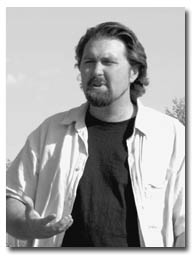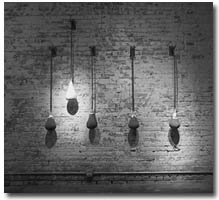|
written by
Amy Maestas
 In
the aftermath of the Missionary In
the aftermath of the Missionary
Ridge and Valley fires this summer,
local artist Shan Wells held a
metaphorical mirror up to his life, attempting to recognize
how the fires’ destruction had changed it. This
was not a small mirror from a vanity case; it was enormous
– to capture both the breadth of Wells’ 6’3”
stature and his emotions.
Wells saw a lot: fear,
pain, loss and uncertainty; he saw raw wounds that
needed healing. Although Wells was not a victim of the
fires’ insidious path,
his inspiration was.
 As
an illustrator and environmental sculptor, Wells’
art comes from nature – As
an illustrator and environmental sculptor, Wells’
art comes from nature –
literally and intellectually. He creates what some call
“eco art” or “land art,” a
movement largely popularized in the 1960s that focuses
on the connection
between humans and nature. His work might include leaves,
stones or flowers. Or it might include burnt twigs and
thick mud, which are part of his sculptures currently
on display at the Cordell Taylor Gallery in Denver.
Wells’ exhibit,
“burn works,” showcases five pieces he created
in response to the devastation of this summer’s
fires as well as past wildfires at Mesa Verde National
Park. The Mesa Verde fires inspired three pieces, Zygote,
Artifact and Arrested Languages, which he created last
year and displayed in Durango. They are, by Wells’
definition, more intellectual than intuitive. But this
year, he added two new pieces to his suite of art, both
of which carry a powerful punch of sorrow and rage, and
have deeper meaning because of their proximity to this
native Durangoan’s back yard.
The most dramatic, Plume
Drawing, is a black-and-white 7-by-10-foot triptych in
pencil and charcoal. It is a vast spiral of smoke rising
from an invisible landscape.
“This drawing
is about the uncontrollable energy of these plumes,”
says Wells. “Its size is meant to evoke the power
that was inside them.”
Swab is a 12-by-10-foot
sculpture of five auger-like farm implements wrapped in
organic cotton and supported by rusted poles. The swabs
are soiled with a slurry of mud and ash, which Wells collected
from the mudslides that deluged the valley after the fires.
 “The
mud and ash from the mudslides were the color and consistency
of chocolate pudding,” he says. “I helped
people who were buried in mudslides. And when I got into
this mud, I noticed that it was like clotted blood. These
mudslides were like the land was hemorrhaging –
like the earth was trying to cleanse itself.” “The
mud and ash from the mudslides were the color and consistency
of chocolate pudding,” he says. “I helped
people who were buried in mudslides. And when I got into
this mud, I noticed that it was like clotted blood. These
mudslides were like the land was hemorrhaging –
like the earth was trying to cleanse itself.”
Swab, Wells says, conveys
the pain that comes after the fire and the need for wounds
to be tended to. One swab remains clean, however.
“This means that
the jobs of conservation and reclamation aren’t
finished, and won’t be for a long time. We also
have a job to do of rebuilding from these fires’
damage to our economy and to our social fabric.”
Wells grew up on East
Animas Road, so when the fires hit, along with his artistic
wellspring, many of his childhood memories went up in
smoke too. He spent much of his childhood picking chokecherries
and mushroom hunting on Missionary Ridge. Many of his
family members still live in the valley. Wells helped
his aunt evacuate her home and helped an uncle clear brush
on his property as a defense. This is why the two new
pieces in his sculptural suite are so particularly painful
and personal. However, these two pieces also are acting
as catharsis, Wells said.
In 1996, Wells, whose
father was a ranger at Mesa Verde, became interested in
learning about the effects wildfires have on nature. That
year and in 2000, he worked with firefighters to understand
the regeneration of the land destroyed by fire and in
turn incorporate it into his work.
“My art is about
conceptual ideas. It is also like a series of questions
about how humanity views nature, how we value it, interpret
it, label it,” says Wells.
“One of the main
things I look for in my art is how to bring us back to
the most basic thing, which is the earth. We use the earth’s
resources to separate us from it. But we shouldn’t.
If things are cut off, like water and snow, everything
else falls away. It only takes a shrug of the earth’s
shoulders for it to crumble.”
As Missionary Ridge
was crumbling under the heat, Wells says he wasn’t
thinking about how it would impact his art, nor was he
immediately aware of any inspiration for future works.
He was immersed in helping family, community members and
firefighters survive. He was also coming to terms with
his own emotions.
“I felt guilty
when the fires started,” he says. “I had wanted
to learn all I could
about what wildfires did to nature and the landscape.
So, when they started, I
thought to myself, ‘Well, here’s your opportunity.
Now you can learn all you
want to know.’ I didn’t want to learn this
way. But I have much more respect for this natural process
now.”
Beyond his own healing,
Wells also is concerned about healing the community. He’s
troubled by the divisiveness that emerged from the finger-pointing
and name-calling once the fires were under control. Blame,
he says, is not helpful. We all share the burden collectively.
“We came together
so beautifully during the fires, and now we’ve become
so
polarized,” he says. “Blaming each other isn’t
going to help us protect ourselves and the forest from
future fires.”
Wells is unsure whether
his two new pieces will be displayed in Durango, although
that’s his desire. But since they are intensely
personal works, and, he says, are in many ways incomplete,
he’s comfortable using them and any future burn
sculptures as salve on his own wounds.
“At the end of
the day, I’ve come not to hate the fires,”
he says. “But there’s
more I personally need to go through before I’m
finished with this.”
|

